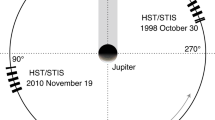Abstract
EUROPA, the second large satellite out from Jupiter, is roughly the size of Earth's Moon, but unlike the Moon, it has water ice on its surface1. There have been suggestions that an oxygen atmosphere should accumulate around such a body, through reactions which break up the water molecules and form molecular hydrogen and oxygen2,3. The lighter H2 molecules would escape from Europa relatively easily, leaving behind an atmosphere rich in oxygen. Here we report the detection of atomic oxygen emission from Europa, which we interpret as being produced by the simultaneous dissociation and excitation of atmospheric O2 by electrons from Jupiter's magnetosphere. Europa's molecular oxygen atmosphere is very tenuous, with a surface pressure about 10−11 that of the Earth's atmosphere at sea level.
This is a preview of subscription content, access via your institution
Access options
Subscribe to this journal
Receive 51 print issues and online access
$199.00 per year
only $3.90 per issue
Buy this article
- Purchase on Springer Link
- Instant access to full article PDF
Prices may be subject to local taxes which are calculated during checkout
Similar content being viewed by others
References
Malin, M. C. & Pieri, D. C. in Satellites (eds Burns, J. A. & Matthews, M. S.) 689–717 (Univ. Arizona Press, Tucson, 1986).
Yung, Y. L. & McElroy, M. B. Icarus 20, 97–103 (1977).
Kumar, S. & Hunten, D. M. in Satellites of Jupiter (ed. Morrison, D.) 782–806 (Univ. Arizona Press, Tucson, 1982).
Vanhoosier, M. E., Bartoe, J. D. F., Brueckner, G. E. & Prinz, D. K. Astro. Lett. Commun. 27, 163–168 (1988).
Hapke, B., Wells, E. & Wagner, J. Icarus 47, 361–367 (1981).
Nelson, R. M. et al. Icarus 72, 358–380 (1987).
Lane, A. L., Nelson, R. M. & Matson, D. L. Nature 292, 38–39 (1981).
Clark, R. N. Icarus 44, 388–409 (1980).
Meier, R. R. Space Sci. Rev. 58, 1–185 (1991).
Sittler, E. C. Jr. & Strobel, D. F. J. geophys. Res. 92, 5741–5762 (1987).
Bagenal, F. J. geophys. Res. 99, 11043–11062 (1994).
Zipf, E. C. J. Phys. B 19, 2199–2209 (1986).
Itikawa, Y. et al. J. Phys. Chem. Ref. Data 18, 23–42 (1989).
Laher, R. R. & Gilmore, F. R. J. Phys. Chem. Ref. Data 19, 277–305 (1990).
Shemansky, D. E. J. geophys. Res. 93, 1773–1784 (1988).
Lee, J.-S. & Meier, R. R. Astrophys. J. 240, 185–195 (1980).
Gladstone, G. R. J. geophys. Res. 97, 19519–19525 (1992).
Meier, R. R. & Lee, J.-S. Planet. Space. Sci. 30, 439–450 (1982).
Johnson, R. E. et al. Geophys. Res. Lett. 10, 892–895 (1983).
Cheng, A. F., Haff, P. K., Johnson, R. E. & Lanzerotti, L. J. in Satellites (eds Burns, J. A. & Matthews, M. S.) 403–436 (Univ. Arizona Press, Tucson, 1986).
Author information
Authors and Affiliations
Rights and permissions
About this article
Cite this article
Hall, D., Strobel, D., Feldman, P. et al. Detection of an oxygen atmosphere on Jupiter's moon Europa. Nature 373, 677–679 (1995). https://doi.org/10.1038/373677a0
Received:
Accepted:
Issue Date:
DOI: https://doi.org/10.1038/373677a0
This article is cited by
-
Oxygen production from dissociation of Europa’s water-ice surface
Nature Astronomy (2024)
-
The Europa Clipper Magnetometer
Space Science Reviews (2023)
-
A comprehensive investigation of the Galilean moon, Io, by tracing mass and energy flows
Experimental Astronomy (2022)
-
Three body photodissociation of the water molecule and its implications for prebiotic oxygen production
Nature Communications (2021)
-
A sublimated water atmosphere on Ganymede detected from Hubble Space Telescope observations
Nature Astronomy (2021)
Comments
By submitting a comment you agree to abide by our Terms and Community Guidelines. If you find something abusive or that does not comply with our terms or guidelines please flag it as inappropriate.



